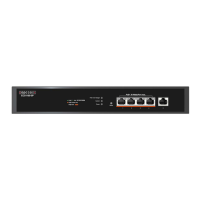Chapter 50
| IP Routing Commands
Global Routing Configuration
– 976 –
IPv4 Commands
ip route This command configures static routes. Use the no form to remove static routes.
Syntax
ip route destination-ip netmask next-hop [distance]
no ip route {destination-ip netmask next-hop | *}
destination-ip – IP address of the destination network, subnetwork, or host.
netmask - Network mask for the associated IP subnet. This mask identifies
the host address bits used for routing to specific subnets.
next-hop – IP address of the next hop router used for this route.
distance – An administrative distance indicating that this route can be
overridden by dynamic routing information if the distance of the dynamic
route is less than that configured for the static route. Note that the default
administrative distances used by the dynamic unicast routing protocols is
110 for OSPF, 120 for RIP, 20 for eBGP, and 200 for iBGP. (Range: 1-255,
Default: 1)
* – Removes all static routing table entries.
Default Setting
No static routes are configured.
Command Mode
Global Configuration
Command Usage
◆ Up to 256 static routes can be configured.
◆ Up to eight equal-cost multipaths (ECMP) can be configured for static routing
using the maximum-paths command.
show ip route Displays specified entries in the routing table PE
show ip route database Displays static or dynamically learned entries in the routing
table
PE
show ip route summary Displays summary information for the routing table PE
show ip traffic Displays statistics for IP, ICMP, UDP, TCP and ARP protocols PE
IPv6 Commands
ipv6 route Configures static routes GC
show ipv6 route Displays specified entries in the routing table PE
Table 2: Global Routing Configuration Commands (Continued)
Command Function Mode

